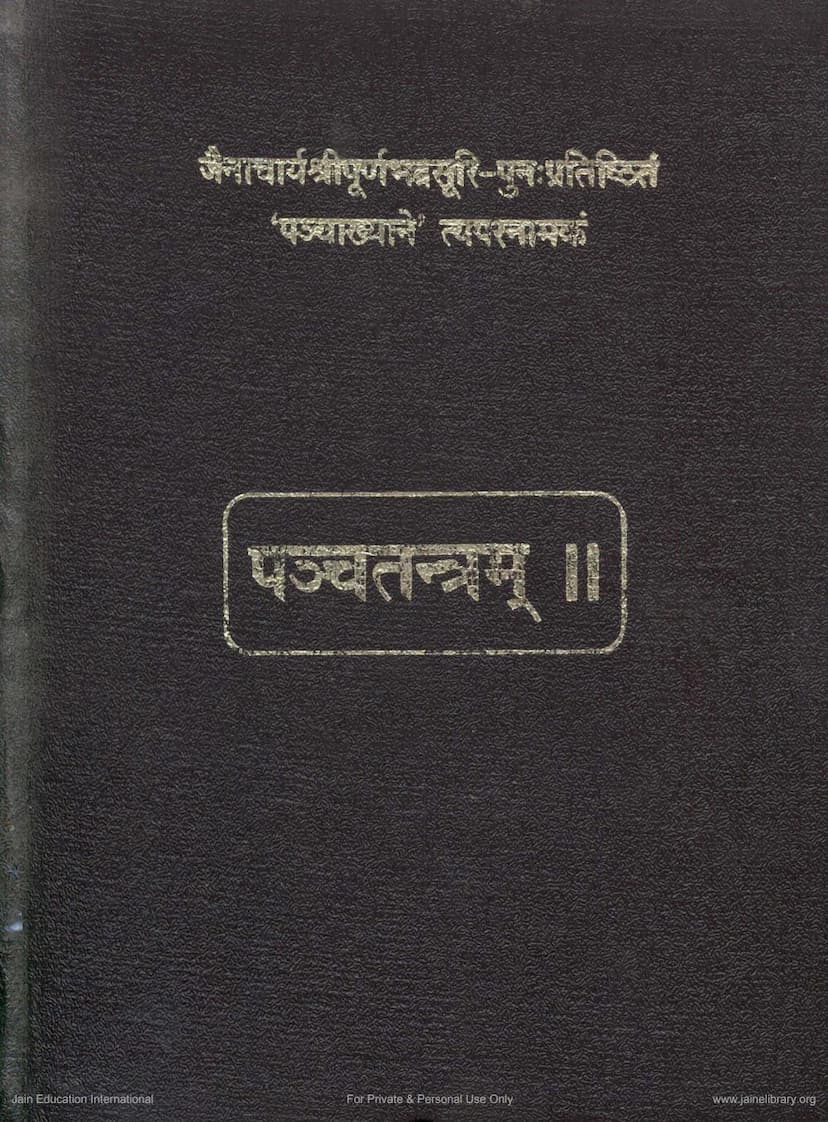Panchtantram
Added to library: September 2, 2025
Loading image...

Summary
This document is a scanned copy of the Jain text "Panchtantram" (also known as "Panchākhyāna"). Here's a breakdown of its content based on the provided pages:
Overall Purpose:
The document is a re-publication of the Panchatantra, presented in a Jain context and dedicated to a specific Jain Acharya. It emphasizes the Jain tradition's role in preserving and transmitting knowledge, even from non-Jain sources.
Key Information Extracted:
- Title: Panchtantram (also referred to as Panchākhyāna).
- Author: Vishnu Sharma (though the Jain re-publication is by Acharya Shri Poornabhadra Suri).
- Publisher: Shri Vishvanandikar Jain Sangh, Ahmedabad.
- Catalog Link: https://jainqq.org/explore/001450/1 (Indicates this is part of a larger digital collection of Jain texts).
- Publication Details:
- Tenth book in the Shri Nemi-Nandan Granthamala series.
- Re-established by Jainacharya Shri Poornabhadra Suri.
- Published in Vikram Samvat 2045 (1988 CE).
- Price: 100.00 Rupees.
- Print run: 500 copies.
- Printer: Jain Advocate Prin. Press.
- Dedication: The book is dedicated to the memory of Param Pujya Acharya Shri Vijay Omkar Surishwarji Maharaj, highlighting his contributions to the Jain order and his martyrdom for peace and prosperity in the Jina Shasan.
- Introduction/Context (Prasangik):
- History of Panchatantra: The Panchatantra's history is traced back over 2300 years. It is popular globally, with translations into over 200 languages. The original author remains unknown, though Vishnu Sharma is traditionally attributed.
- Jain Scholarly Contribution: The introduction clarifies that the original author was not Jain. However, it highlights that Jain scholars and saints have actively studied, preserved, and transmitted numerous non-Jain texts.
- Acharya Poornabhadra Suri's Role: The text emphasizes that the ancient reading of Panchatantra was lost or corrupted by the 12th-13th century Vikram era. In VS 1255 (1199 CE), at the request of Minister Som, Jainacharya Shri Poornabhadra Suri undertook a significant task of refining, re-editing, and re-compiling the available fragments of the Panchatantra. This resulted in the accurate and well-organized version presented in this publication.
- Jain Honesty and Tolerance: The introduction praises the Jain acharyas' honesty by not altering the original intent of the Panchatantra and even including the traditional attribution to Vishnu Sharma. It also notes their practice of not beginning with Jain-specific prayers (like Jinanamaskaran or Guru Vandana) in such works, which is seen as an example of Jain liberality and tolerance.
- Jain Literature on Panchatantra: The introduction mentions the prevalence of Panchatantra themes in medieval Jain literature, citing various "Ras" and "Chopai" works based on its narratives.
- Dr. Johannes Hertel's Contribution: The publication of the version featuring Acharya Poornabhadra Suri's reading was first done by Professor Johannes Hertel, an Italian Sanskrit scholar, in 1908. Hertel dedicated many years to finding, editing, and annotating the Panchatantra, producing five volumes on the subject. His meticulous work, involving the comparison of numerous manuscripts, is highlighted as an exemplary model of dedication and scholarship, especially for a foreign scholar working in India.
- Importance of the Jain Version: The introduction suggests that without Hertel's publication, the significant contribution of a Jain acharya to the Panchatantra's preservation might have remained unknown to the Jain community. It laments the decline in literary knowledge among Jain monks today.
- Motivation for Re-publication: The re-publication was inspired by a desire to make this important text accessible, especially in light of its inclusion in a curriculum for Jain monks and nuns at a convention in Ahmedabad.
- Editorial Notes: The re-publication is an offset reprint of Hertel's 1908 edition. Corrections from Hertel's errata are included. Sanskrit and alphabetical indexes of stories and verses are added. Hertel's English introduction and an article on Indian writing systems were omitted as deemed unnecessary for the target audience.
- Hertel's Method: The introduction explains Hertel's approach to sandhi (joining of words) and conjunct consonants, often separating them for easier reading by foreign audiences, and using specific symbols to clarify vowel sandhis.
- Table of Contents (Vishayanukramah): This section provides a detailed list of the stories within each of the five tantras (books) of the Panchatantra, along with their corresponding page numbers. The structure follows the typical Panchatantra division:
- Pratham Tantra - Mitra Bhedah (Separation of Friends): Covers stories like the lion and the bull, the ape and the wedge, etc.
- Dwitiya Tantra - Mitra Samprāptih (Gaining of Friends): Includes tales about the bird with two necks, the mice and the elephant, etc.
- Tritiya Tantra - Kākolūkiyam (Crows and Owls): Features stories like the war between crows and owls, the Brahman and the goat, etc.
- Chaturtha Tantra - Labdhapraṇāśam (Loss of Gains): Contains stories like the ape and the crocodile, the frog's revenge, etc.
- Panchama Tantra - Aparikṣitakāritvam (Unforeseen Actions / Rashness): Includes tales of the barber who killed the monks, the Brahmanee and the faithful mongoose, the ape's revenge, etc.
- Selected Tales (indicated by page numbers): The table of contents lists many familiar Panchatantra stories. The text then provides the actual stories from the book, starting with the introductory story (Kathamukham) and then moving into the first tantra, "Mitra Bhedah," with the famous "Lion and Bull" frame story and its nested tales.
In essence, this document is a valuable Jain scholarly edition of the Panchatantra, underscoring the Jain community's rich heritage of intellectual preservation and appreciation of diverse literary works.